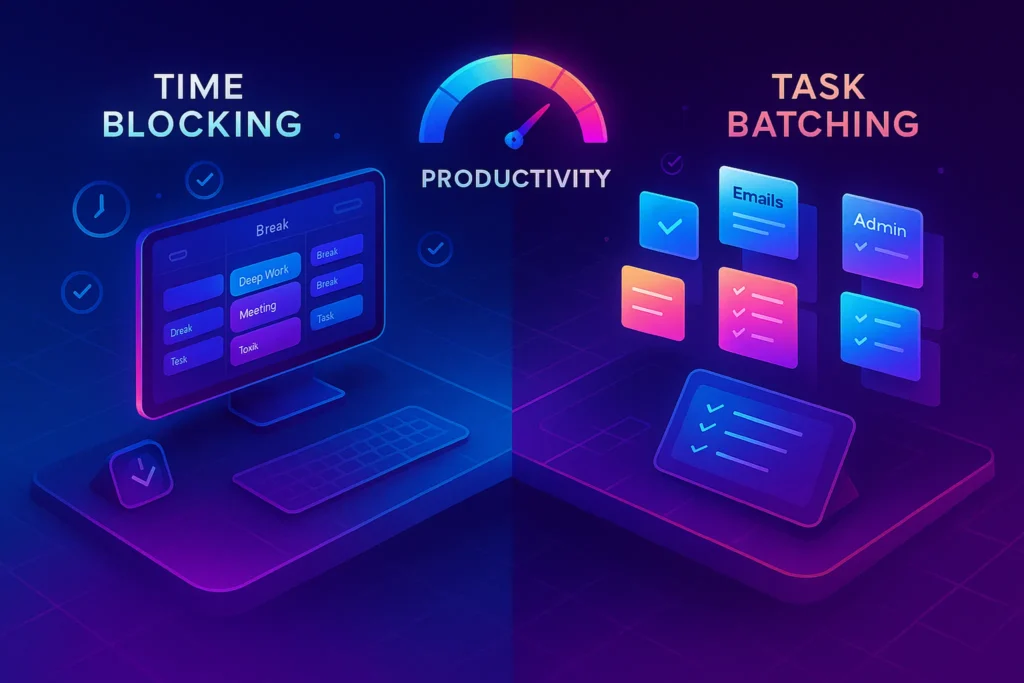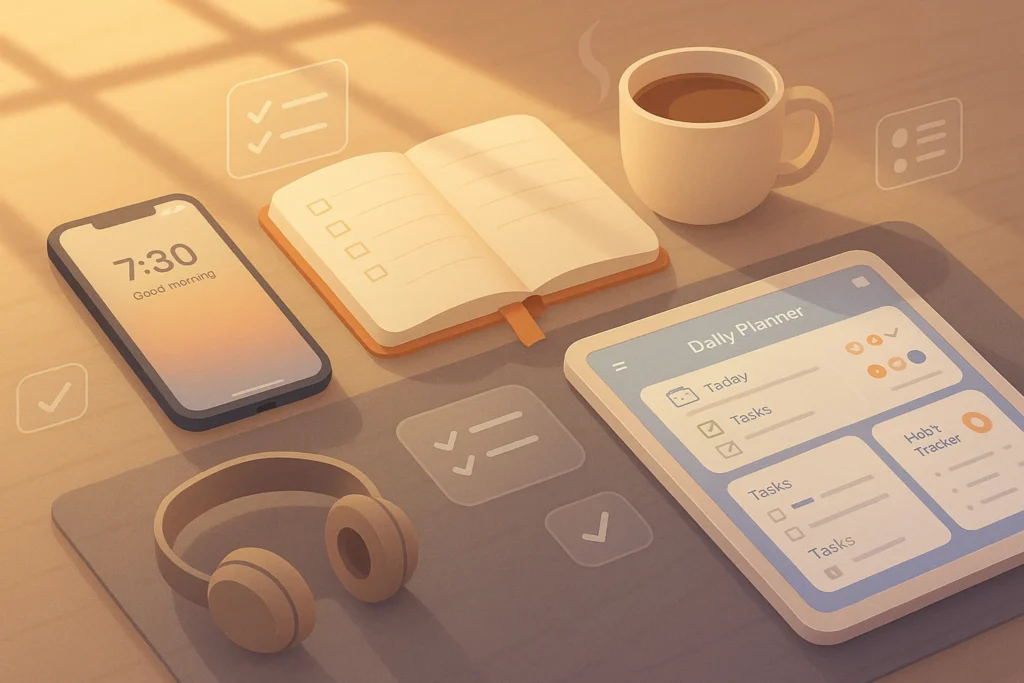⏱️ Intro: Why Managing How You Work Matters as Much as What You Do
Most people think being productive means just doing more in less time. But the truth is, how you structure your work often matters more than what you’re working on.
Two of the most powerful—but often misunderstood—methods in productivity are Time Blocking and Task Batching. While they sound similar, they serve different functions—and combining them can lead to significant boosts in focus, efficiency, and creative flow.
In this guide, we’ll explore:
-
What each method really means (and doesn’t)
-
When to use which
-
How to combine them in a smart hybrid system
-
Practical tips and real-life use cases
If you’ve tried productivity hacks before and found them unsustainable, this post will help you build a system that actually works.
📅 What is Time Blocking?
Time Blocking is the practice of scheduling tasks or categories of tasks directly into your calendar, assigning fixed time slots for each.
Instead of working from a to-do list, you work from a calendar map of your intentions.
🧠 Key Benefits:
-
Reduces decision fatigue (“What should I work on now?”)
-
Prevents overbooking or multitasking
-
Creates structured space for deep work, meetings, breaks, etc.
🧭 Example:
A content creator blocks 9:00–11:00 AM for writing blog posts, 11:00–12:00 for email responses, 1:00–2:30 PM for video editing—and so on.
This system is especially helpful for roles that require creative deep work or context switching control, like designers, developers, founders, or writers.
📌 Looking for an in-depth breakdown of how to design this system from scratch? Don’t miss How to Set Up a Productivity System That Actually Works.
🧩 What is Task Batching?
Task Batching is about grouping similar tasks together and doing them back-to-back to reduce mental switching costs.
Instead of checking emails, making phone calls, and editing a video all in one afternoon, batching would mean doing all emails together, all calls together, and all creative tasks together.
🧠 Key Benefits:
-
Minimizes context switching
-
Helps achieve “flow” with repetitive or similar tasks
-
Increases focus and energy efficiency
🧭 Example:
A social media manager schedules 2 hours on Tuesday to create all content for the week, rather than creating and posting daily.
This technique shines in roles with repetitive or system-driven outputs, such as marketers, administrators, editors, and customer support pros.
If you’re exploring scientifically-backed ways to boost output without burnout, we strongly recommend Top Productivity Hacks Backed by Science for complementary strategies.
🧪 Time Blocking vs Task Batching: Key Differences
| Aspect | Time Blocking | Task Batching |
|---|---|---|
| Focus | Managing time & energy | Managing mental mode & focus |
| Tool | Calendar-based | Task-type grouping |
| Structure | Structured by hours | Structured by task similarity |
| Strength | Deep work, diverse schedule | Repetition, speed, flow |
| Weakness | Can feel rigid | Can be inefficient without boundaries |
⚠️ Common Pitfall:
Many people confuse blocking with batching. Blocking is when. Batching is what.
And the magic happens when you use them together.
If you’re looking for an evidence-based system for choosing the right method based on your brain type and energy cycles, check out The Science of Productivity for a deeper dive.
🎯 When to Use Which Method?
✅ Use Time Blocking when:
-
Your day has high task diversity
-
You need to protect deep work slots
-
You want a visual map of your workload
✅ Use Task Batching when:
-
You’re doing repetitive, similar-format tasks
-
You want to work in flow with fewer cognitive switches
-
You’re prepping bulk content or data
Real-world crossover:
Many solopreneurs combine them. For example, they batch create content (e.g., 4 blog posts in a day) but use time blocking to decide when to do that batch (e.g., Tuesday 9:00–1:00).
Need help balancing your weekly commitments? Our post on How to Plan Your Week Like a Pro walks you through visual scheduling using both systems.
🧠 Practical Examples by Role
🎨 Freelance Designer:
-
Time Blocking: 2 hrs for client work, 1 hr for outreach, 30 min admin
-
Batching: All client emails answered together at end of day
🎥 YouTuber or Video Editor:
-
Time Blocking: Mornings = scripting; Afternoons = editing
-
Batching: Shoot all B-roll for multiple videos on the same day
📣 Social Media Manager:
-
Time Blocking: Friday mornings for analytics + strategy
-
Batching: Create all next week’s posts + captions in one 3-hr window
🧑💻 Developer:
-
Time Blocking: 3 hr no-interruption coding block in AM
-
Batching: Handle all GitHub PR reviews back-to-back at 4 PM
Build a Workflow That Works With You
⏰ Want a Smarter System for Your Day?
Whether you’re managing deep work or daily tasks, the right mix of structure and flexibility can transform your productivity.
🔹 Get weekly tips on sustainable time systems & creative output
🔹 Discover real workflows from founders, creators & remote pros
👉 Join the Productive Nerd Brief — built for people who think before they plan.
🔐 100% privacy. No noise. Just value-packed content tips from NerdChips.
🧬 Hybrid System: How to Combine Both for Peak Efficiency
The most effective creators and professionals don’t choose between Time Blocking and Task Batching—they blend both into a system:
🔧 The Hybrid Stack:
-
Start your week by identifying tasks to batch (e.g., writing, editing, admin)
-
Assign time blocks to each batch in your calendar
-
Use color-coding to visually separate types (deep work vs admin vs meetings)
-
Leave 10–15% “flex space” to handle unexpected interruptions
-
Review and tweak weekly for capacity and energy insights
This layered approach mirrors frameworks used in our comparison of Time Blocking vs. Pomodoro, where we found hybrid methods often yield higher consistency.
🧭 Schedule Based on Your Energy, Not Just Your Task List
While most productivity advice focuses on “what to do when,” the smarter approach is to align tasks with your energy rhythms.
Ask yourself:
-
When am I mentally sharp?
-
When do I tend to crash?
-
When do I naturally feel creative or social?
Then schedule accordingly:
-
Morning high focus? Use Time Blocking to protect deep creative slots (e.g., writing, coding)
-
Post-lunch dip? Batch shallow tasks like email replies, formatting, or admin
-
Evening energy left? Reserve that for casual planning or brainstorming sessions
🧠 Productivity isn’t just about the method. It’s about matching the method to your biology.
📈 Metrics That Matter: Track Your Real Productivity
You can’t optimize what you don’t measure.
Instead of relying on gut feelings (“I think batching works for me”), start logging your system use and noticing the patterns.
Try a simple weekly self-tracking log with these 3 metrics:
| Metric | Example Entry |
|---|---|
| Method Used | Time Blocking, Batching, Both |
| Focus Hours Gained | 4.5 hrs (deep work) |
| Mental Fatigue (1–10) | 6 (felt solid till 4pm) |
After 2–3 weeks, review:
-
Which method consistently gives you more creative output?
-
On what days do you feel burned out—and what method were you using?
📌 Even a manual journal or a tool like Toggl Track can give you the insights needed to fine-tune your personal system.
🛠 Tools to Support Your System
🛠 Tools to Support Your System
✅ For Time Blocking: Google Calendar, Sunsama, Akiflow, Notion’s Calendar View
✅ For Task Batching: Trello, Motion, TickTick, Workflowy
✅ For Hybrid Use: Combine Notion for planning + Google Calendar for scheduling, or even use ChatGPT to draft your week dynamically
🧩 Tools are just tools—but the right one reduces friction and makes your system *stick*.
🧠 Nerd Verdict
Both Time Blocking and Task Batching are powerful on their own—but they’re even more effective when combined with intention.
The key is knowing:
-
When your brain is sharpest (use that for blocking deep work)
-
Which tasks benefit from rhythm (batch those in low-focus hours)
-
And when to adjust without guilt—productivity isn’t rigidity; it’s adaptability
Productivity isn’t about filling your calendar.
It’s about controlling your focus, energy, and outcomes—on your terms.
❓FAQ: Time Blocking vs Batching
💬 Would You Bite?
Which one has worked better for you so far—Time Blocking or Task Batching?
Or do you already blend both without knowing it?
👇 Share your system, struggles, or wins below—we’d love to hear your workflow!



